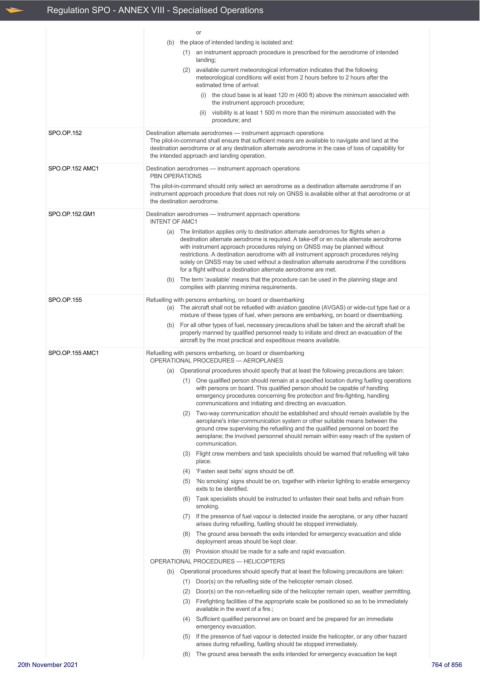Page 764 - UK Air Operations Regulations 201121
P. 764
~
~ Regulation SPO - ANNEX VIII - Specialised Operations Centrik
or
(b) the place of intended landing is isolated and:
(1) an instrument approach procedure is prescribed for the aerodrome of intended
landing;
(2) available current meteorological information indicates that the following
meteorological conditions will exist from 2 hours before to 2 hours after the
estimated time of arrival:
(i) the cloud base is at least 120 m (400 ft) above the minimum associated with
the instrument approach procedure;
(ii) visibility is at least 1 500 m more than the minimum associated with the
procedure; and
SPO.OP.152 Destination alternate aerodromes — instrument approach operations
The pilot-in-command shall ensure that sufficient means are available to navigate and land at the
destination aerodrome or at any destination alternate aerodrome in the case of loss of capability for
the intended approach and landing operation.
SPO.OP.152 AMC1 Destination aerodromes — instrument approach operations
PBN OPERATIONS
The pilot-in-command should only select an aerodrome as a destination alternate aerodrome if an
instrument approach procedure that does not rely on GNSS is available either at that aerodrome or at
the destination aerodrome.
SPO.OP.152.GM1 Destination aerodromes — instrument approach operations
INTENT OF AMC1
(a) The limitation applies only to destination alternate aerodromes for flights when a
destination alternate aerodrome is required. A take-off or en route alternate aerodrome
with instrument approach procedures relying on GNSS may be planned without
restrictions. A destination aerodrome with all instrument approach procedures relying
solely on GNSS may be used without a destination alternate aerodrome if the conditions
for a flight without a destination alternate aerodrome are met.
(b) The term ‘available’ means that the procedure can be used in the planning stage and
complies with planning minima requirements.
SPO.OP.155 Refuelling with persons embarking, on board or disembarking
(a) The aircraft shall not be refuelled with aviation gasoline (AVGAS) or wide-cut type fuel or a
mixture of these types of fuel, when persons are embarking, on board or disembarking.
(b) For all other types of fuel, necessary precautions shall be taken and the aircraft shall be
properly manned by qualified personnel ready to initiate and direct an evacuation of the
aircraft by the most practical and expeditious means available.
SPO.OP.155 AMC1 Refuelling with persons embarking, on board or disembarking
OPERATIONAL PROCEDURES — AEROPLANES
(a) Operational procedures should specify that at least the following precautions are taken:
(1) One qualified person should remain at a specified location during fuelling operations
with persons on board. This qualified person should be capable of handling
emergency procedures concerning fire protection and fire-fighting, handling
communications and initiating and directing an evacuation.
(2) Two-way communication should be established and should remain available by the
aeroplane's inter-communication system or other suitable means between the
ground crew supervising the refuelling and the qualified personnel on board the
aeroplane; the involved personnel should remain within easy reach of the system of
communication.
(3) Flight crew members and task specialists should be warned that refuelling will take
place.
(4) ‘Fasten seat belts’ signs should be off.
(5) ‘No smoking’ signs should be on, together with interior lighting to enable emergency
exits to be identified.
(6) Task specialists should be instructed to unfasten their seat belts and refrain from
smoking.
(7) If the presence of fuel vapour is detected inside the aeroplane, or any other hazard
arises during refuelling, fuelling should be stopped immediately.
(8) The ground area beneath the exits intended for emergency evacuation and slide
deployment areas should be kept clear.
(9) Provision should be made for a safe and rapid evacuation.
OPERATIONAL PROCEDURES — HELICOPTERS
(b) Operational procedures should specify that at least the following precautions are taken:
(1) Door(s) on the refuelling side of the helicopter remain closed.
(2) Door(s) on the non-refuelling side of the helicopter remain open, weather permitting.
(3) Firefighting facilities of the appropriate scale be positioned so as to be immediately
available in the event of a fire.;
(4) Sufficient qualified personnel are on board and be prepared for an immediate
emergency evacuation.
(5) If the presence of fuel vapour is detected inside the helicopter, or any other hazard
arises during refuelling, fuelling should be stopped immediately.
(6) The ground area beneath the exits intended for emergency evacuation be kept
20th November 2021 764 of 856

